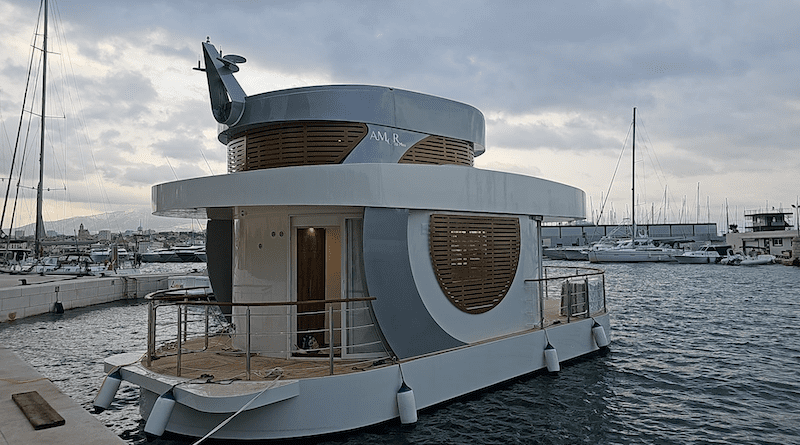Launch Of First Croatian Floating Apartment: Rapidly Growing New Market Niche – OpEd
Climate change and the constant increase in real estate prices have forced countries to explore the oceans as another habitable place.
What is a floating house market?
According to the credible reports, the current floating-house market is worth USD1.5 billion in 2023, and it is estimated to increase to USD3.7 billion by the end of 2030 with a compounded annual growth rate of 17.7% within the projected period 2023-2030.
These properties manufactured to float on the water, like rivers, lakes, or oceans waters, is identified as the “floating house market.” These innovative homes, sometimes called houseboats or floating apartments, offer a unique living experience by blending the peace and harmony of the waterfront with the amenities of modern conventional home.
Floating houses are renowned by their buoyant structures, which are the results of resources and engineering methods used to assure stability and durability on the water. They provide broad range of tastes and choices by incorporating different architectural models, from sleek and modern designs to more traditional and cozy aesthetics.
A number of elements have contributed to the outstanding growth of the floating house market. Manufacturers and architects are now looking into innovative ways to address the lack of housing and the high demand for prime waterfront locations due to urbanization and population density in waterfront areas, which has augmented interest in alternative living possibilities. In addition, real estate buyers are looking for a unique living experience are drawn to the attraction of a calm and outdoorsy lifestyle when paired with the option of expansive views, waterfront access and on-water navigability.
The floating house market has surged in recent years, driven by a fusion of sustainability, innovative design, navigability and the allure of waterfront living. With a growing emphasis on eco-friendly structures and adaptable lifestyles, these homes represent a compelling shift in modern architecture, catering to an increasing demand for unique, water-bound dwellings. Pioneering technologies and creative solutions have pushed the floating house market into a realm of unprecedented growth and captivation.
The growing reception of sustainable lifestyle is one of the prime trends in the floating house industry. Floating houses have many advantages for those people who are concerned about the environmental impact of their lifestyle and areas of residence. For example, since they are usually much smaller than conventional houses. Floating houses use a reduced amount of energy to heat and cool. To increase the floating-houses sustainability, it can come with solar panels and other renewable energy sources.
The growing demand from luxury homebuyers is another trend in the floating house market. These residences can be just as opulent as conventional luxury homes are, and they frequently have cutting-edge features and finishes. Many factors, such as the desire for exclusive and distinctive homes, the desire to live near the water, and the desire to own an environmentally friendly home, are increasing the demand for luxury floating houses.
The market for leasing out floating houses is growing as well. The aspiration to experience living in a floating house, the increasing prices of housing in many areas, and the rising popularity of short-term rentals are some of the reasons for this. Compared to conventional hotel rentals, floating house rentals have a lot of advantages. For instance, they provide a more unique and memorable experience in addition to being roomier and rationally priced.
Recent Development in Croatia
The Croatian maritime start-up Oasis Meu, owned by the Caelum 1029 Company, recently completed the development of a modern floating apartment that the company calls it the Oasis Amor model.
This Split based Croatian company has introduced a dream home that looks like a modern luxury floating apartment powered by solar energy, which can lead to a sustainable lifestyle.
According to the company website, their two stories/decks floating apartment provides a comfortable accommodation for 2+2 persons with a 360° panoramic view from the sleeping area on the upper deck. On its main deck is a saloon, a fully equipped kitchen and bathroom. Its bow deck is made for lounging, sunbathing and soaking in the jacuzzi. The goal of this floating apartment is to offer freedom like the one that only ships can offer, but with the comfort of the house. This model expands the accommodation offer that meets all berthing conditions in marinas, anchoring spots and bays that could lead to business activities for hotels, marinas and resorts.
The company claims that this innovative model integrates a new living experience into a symbiotic system that uses the sea as a flexible living place.
The concept of houses on the water is not unknown. In the European market, there is a serious production of such objects, but primarily immobile and very often unimaginatively designed, roughly like boxes or containers. As the owner Maja Regjo says, ‘Amor’ is navigable – but very attractive with its oval shape, one of a very unique kind.
Considering this industry’s recent development, the vision for the world’s sustainable city on water looks feasible today. One could consider this another development towards the vision of sustainable cities and settlements in the 21 century.
References

